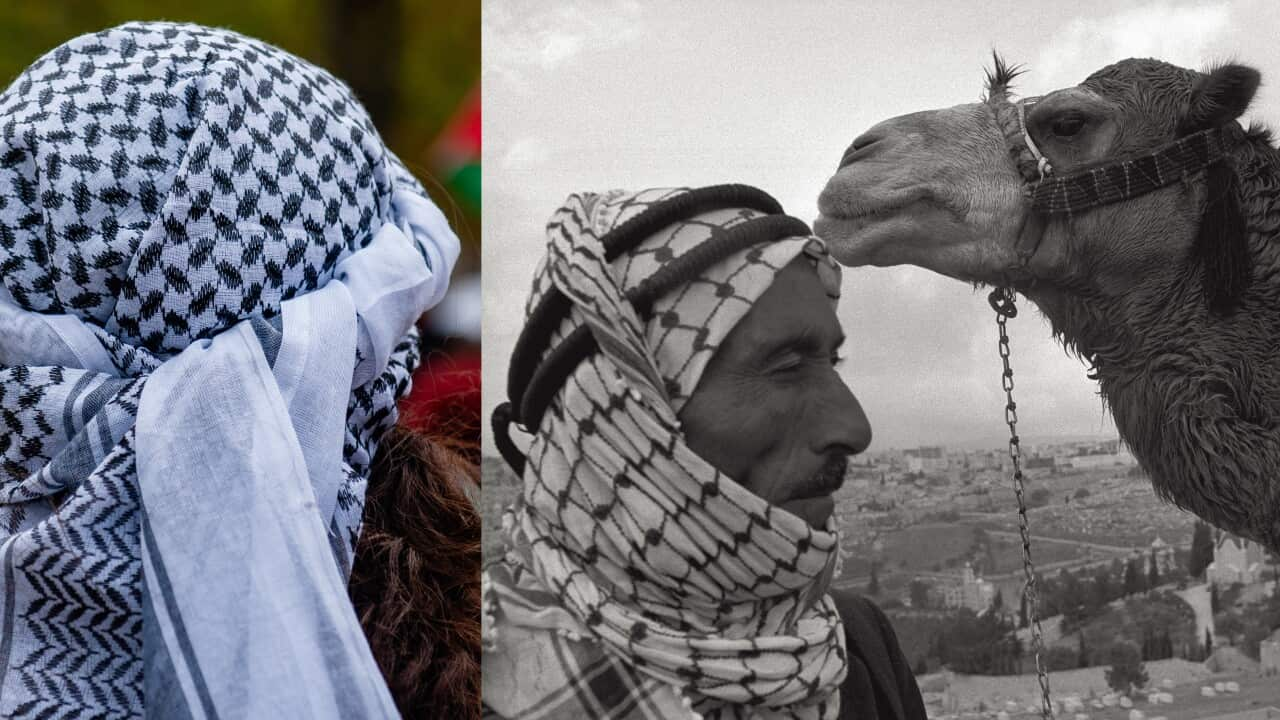A common piece of attire worn at pro-Palestine rallies across the globe is the black and white, red and white, or just white, scarves, which have a long history.
The keffiyeh has been worn by Palestinians and across the Arab world for “hundreds and hundreds of years,” explains Dr Anas Iqtait, an Australian National University lecturer.
“It is as deep as the Palestinian identity,” he said.
While the scarf is synonymous with the Palestinian people, studies suggest the origins lie further east in the area known today as Iraq.
The word is connected with the Iraqi city of Kufa, south of Baghdad along the Euphrates River.
It is sometimes called a hatta in the Levant dialect, and ghatrah in the Gulf region.
From a headdress to a symbol
The modern keffiyeh among Palestinian populations emerged during the Ottoman period when farmers wore it to protect them from the sun and the cold during winter as they worked their fields.
“The keffiyeh was standardised, across both the urban and (agricultural) communities, in Palestine as a symbol of unity, and a political statement against the British colonisation of Palestine,” Dr Iqtait said.

Keffiyeh have become a significant part of Palestine's history. Credit: Joel Carillet/Getty Images
The Mandate required Britain to put into effect the Balfour Declaration's "national home for the Jewish people" alongside the Palestinian Arabs.
The Palestinian rebel group known as the Fedayeen wore the keffiyeh over their entire heads to cover their faces to conceal their identities and avoid arrest.
At pivotal moments in Palestinian history, the keffiyeh was adopted as a sign of solidarity.
In the 1960s, with the emergence of the modern Palestinian resistance movement following the establishment of the state of Israel post World War II, the keffiyeh accompanied its leaders and became a symbol of resistance.
Dr Iqtait said the keffiyeh had become one of the “most recognisable symbols of the Palestinians”.
“Both in terms of heritage and culture, and also in terms of plight, political plight for men and right of self-determination, and anti-colonial Palestinian movements and anti-occupation movements.”
'Yasser Arafat introduced the world to the keffiyeh'
It was also around this time that the late Palestinian leader, Yasser Arafat, popularised the keffiyeh among a global audience, according to Australian National University research scholar, Khalid Al Bostanji.
"He turned an Arab headdress that most likely comes from another part of the Arab region into a Palestinian national symbol," he said.
"Some people say that he purposefully shaped the front of his keffiyeh in a triangular fashion to represent the map of Palestine."

Late Palestinian Leader, Yasser Arafat, was part of making the keffiyeh globally popular. Source: AP / NASSER NASSER/AP
Mr Arafat was a joint Nobel Peace Prize winner for leading the Palestine Liberation Organisation to a peace agreement with the Israeli government in 1994.
The prize was shared with Israeli prime ministers, Yitzhak Rabin and Shimon Peres.
The popularity of its pattern has even made its way into the global fashion industry, reaching a point where the world's fashion giants have engaged in "cultural appropriation ... without crediting Palestinian/Arab culture or the Palestinian struggle", according to Mr Al Bostanji.
What do the patterns on the keffiyeh mean?
The embroidery and inscriptions on keffiyeh designs also have deep meanings rooted in Palestinian history and culture.

The black and white keffiyeh has a deeper meaning connected to Palestinian culture. Source: AFP / HAZEM BADER/AFP via Getty Images
The fishing net pattern is representative of the importance of the Mediterranean to Palestinians and their livelihoods.
The broad line represents the trade routes that passed through Palestine, which brought with them travel and cultural exchange.
Dr Iqtait said it was important to "demystify" any misconceptions of the keffiyeh during a time of war.
"It is a political symbol, it does signify solidarity with Palestinians, it does symbolise the plight of the Palestinians," he said.
"At the same time, it also goes beyond that and it's a cultural symbol that Palestinians have been wearing and using for a very, very long time."
